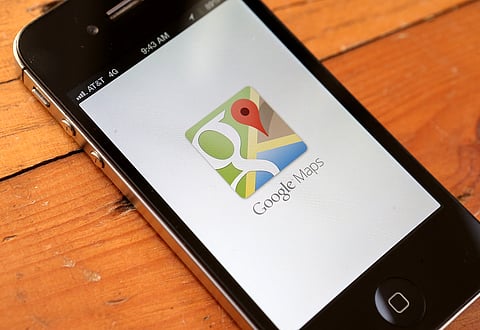Wrong turn: Google Maps sends car dangling off flyover in India
The driver blindly followed Google Maps, unaware the flyover was incomplete

In a dramatic late-night scare, a car traveling from Nepal to Gorakhpur, India, narrowly escaped a deadly fall after it drove onto an under-construction flyover and was left hanging off the edge on National Highway 24 near Bhaiya in Uttar Pradesh.
The incident occurred around 1am (local time) on Sunday. According to reports, the driver was relying on Google Maps, which did not indicate that the flyover was incomplete. In the darkness, the vehicle drove directly onto the unfinished structure. The driver hit the brakes just in time to avoid going over the edge, leaving the car perilously dangling mid-air.
Locals rush to help
Hearing a loud noise, nearby residents rushed to the scene and assisted the car's occupants in escaping safely. Fortunately, no one was injured. A video of the car hanging off the flyover quickly went viral on social media, sparking intense discussion.
By the time police arrived, the car had already been removed with the help of a crane arranged by the construction agency. The occupants had left the scene without informing the authorities.
No barricades or warning signs present
The highway, a key route connecting India and Nepal via the Gorakhpur-Sonauli corridor, is currently undergoing major infrastructure upgrades. Despite ongoing construction, locals and internet users noted the lack of barricades or warning signs at the site, which allowed the vehicle to access the unfinished flyover.
Is Google Maps to blame?
The incident has reignited debate over the reliability of digital navigation tools and the responsibility of construction firms. While some blame Google Maps for not reflecting the construction status, others point to the clear failure of the contractor to secure the site.
One Reddit user remarked, “It’s not Google’s fault. It’s the contractor’s responsibility to barricade and put up proper signage.” Another added, “If a road looks open, people will drive on it. There must be clear barriers. The contractor should be held accountable.”
Is this a wake-up call for Google Maps accuracy
As the video continues to circulate online, the incident serves as a stark reminder of the dangers of blindly trusting digital maps and the urgent need for robust safety measures at construction sites. It has also prompted renewed calls for better coordination between infrastructure developers and digital map providers.
Navigation gone wrong: Glitches in Google Maps
The recent near-miss of a car dangling off an unfinished flyover in Uttar Pradesh is just one of many incidents highlighting Google Maps' flaws—ranging from close calls and wedding mix-ups to missed flights.
Fatal misdirection
Last November, three men died in Uttar Pradesh when their car, following Google Maps, drove off an unfinished flyover into the Ramganga River. Traveling to a wedding from Gurugram, they were unaware the bridge was incomplete. Google expressed condolences and is cooperating with authorities.
Wedding misguided in Kerala
In May 2025, a wedding in Kerala was disrupted when the groom’s party arrived at the wrong temple—60 km away—due to a wrong Google Maps link, but the ceremony went ahead despite the delay.
Tourists trapped in forest
In December 2024, a Bihar family was stranded overnight in Karnataka’s Bheemgad forest after Google Maps led them onto an unpaved road with no mobile signal. Authorities said this wasn’t the first such case.
Missed flights
A Bengaluru traveler missed his flight after Google Maps underestimated travel time. His trip, estimated at 1 hour 45 minutes, took 3 hours due to rain and traffic.
These recurring episodes have prompted growing concerns over the reliability of navigation apps, especially in areas with incomplete data, ongoing construction, or remote terrain. As dependence on digital maps grows, experts and users alike are calling for improved accuracy and better integration with local infrastructure updates.
Sign up for the Daily Briefing
Get the latest news and updates straight to your inbox



